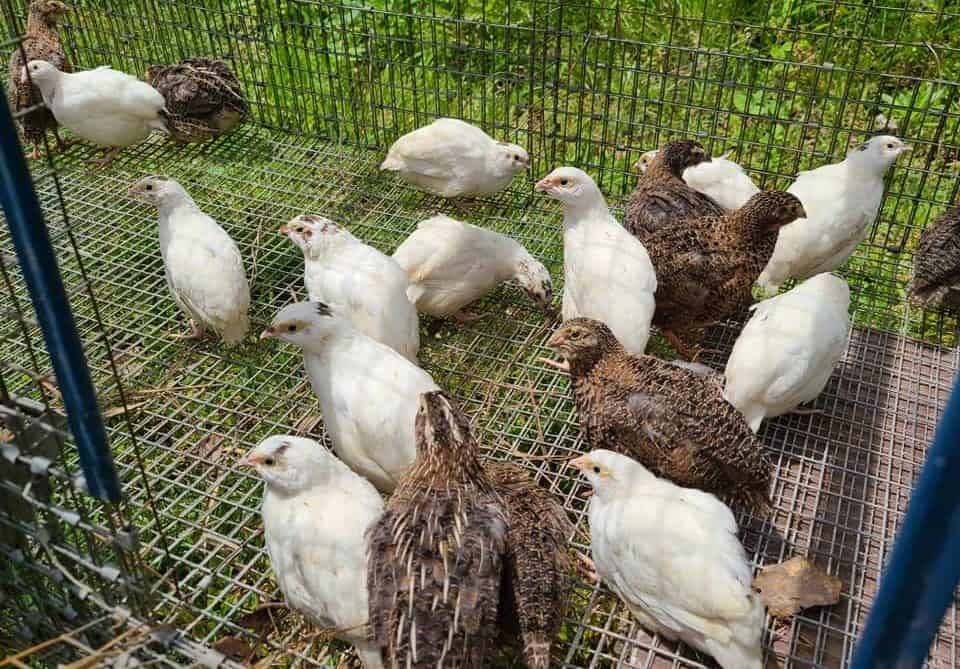Raising quail is becoming more popular. Domesticated quail are worth raising due to their (what I think are their) delicious eggs, tender meat, and manageable size. They are dual-purpose birds.
These small birds are easy to raise as backyard poultry. This means whether you’re a seasoned poultry pro or a homesteading novice, you’ll probably find quail easy to care for.
I explain everything to know about how to raise a healthy flock of quail.
Why Raise Quail?
Quails are becoming a popular staple in plenty of homesteads. There are several reasons people raise quail in their backyards.
Quail usually do well alongside chickens and ducks or on their own. Below are some of the most popular reasons to raise quail.
Raising Quail for Meat
Since quail are small in size, many people assume they don’t make good meat birds. While it’s true that the yield per bird is less than with something such as a chicken or a turkey, quail also have a much quicker turnaround time than other types of poultry.
Meat Production
Meat chickens can take as long as 12 weeks to reach maturity, however, quail are ready in just 7 weeks. Quail farming often makes sense because they require less space, so you can raise more birds at once in your flock. Most quail are prolific egg layers, so it’s doable to keep a healthy flock going for years.
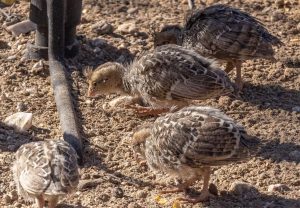
Meat Quality
For many people, the taste alone is enough to convince them that raising quail is a worthwhile endeavor. Quail meat is rich, tender, and gamey, lending a savory quality to any dish.
Quail is favored in many cuisines worldwide, including French, Japanese, Spanish, Portuguese, Italian, and Indian.
The quail is small, making it easier to harvest than other birds. Plus, the meat is wonderfully flavorful. Since the bones are small and very difficult to remove, when cooked and soft, people sometimes eat them along with the meat.
Plus, even after the prime egg-laying period is over, which is around one year, the meat will still taste great, whether you fry or roast it.
Raising Quail for Eggs
Quail not only reach harvesting size more quickly than chickens, but they also start laying eggs earlier. Quail typically start laying at around two months old, while chickens will often take up to six months before producing their first egg.
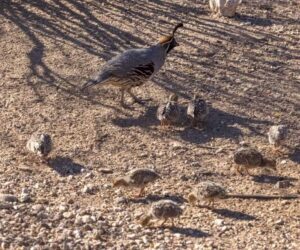
Egg Production
Typically when they lay, they lay many eggs at once. How many eggs they lay at a time is called a clutch. An average clutch can be 10 – 15 or more eggs.
Most domesticated quail breeds will produce around one egg per day when they’re not molting, making them a prolific choice of layer. They typically do not lay eggs in cold months.
Though quail eggs are small, they have a hearty yolk.
While you may need several codorniz eggs to equal the chicken egg’s weight, quails are also very efficient in converting feed. That means you’ll spend less on feed to produce the same weight amount of eggs.
Their eggs are also attractive as an ornamental addition to your dishes. They’re delicate and petite, coming in a variety of different creamy colors. Most are also speckled with either deep red or brown coloration.
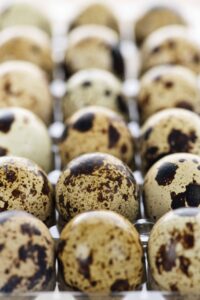
Raising Quail as Pets
While fresh meat and eggs are nice to have around the kitchen, not all quail owners consider their birds to be barnyard workers. Some people keep quail simply because they’re small, friendly, and fairly easy to care for.
Many breeds also make an attractive addition to any yard, with bold coloration and playful plumes.
Some quail breeds have such intricate feathers that fishermen have been known to make lures from them. You can also find quail feathers used in arts and crafts, fashion, jewelry, and more. Most feathers are petite in size, making them ideal for small-scale projects.
More Reasons to Raise Quail
Space Saver
Quails are smaller birds than chickens, so they need less space to live, lay, and breed. As a general rule of thumb, the space quails need is around 3x less than the space chickens need.
As such, if you were concerned about finding space to keep quail, then you really don’t need much! Likewise, if your garden is too small to keep chickens, then quail might be an ideal alternative for you to consider.
Lastly, although not ideal for free-range enthusiasts, these birds do tend to do well in small cages. Giving them access to roam in an enclosed chicken run, along with fresh air and sunshine is best. They will do well being able to forage and blend into their surroundings, helping protect them from predators.

Little or No Legislation
In some cities, keeping chickens can be prohibited or severely restricted, making it difficult for people who want to run urban farms. For example, in some metro areas, you have to apply for a license to keep just four chickens. Plus, oftentimes, you’re not allowed to keep roosters. Hence, you can’t breed them, limiting your profits.
If your city or town doesn’t allow chickens, it may make exceptions to a game bird such as the quail. It may not mention quail in the regulations at all.
One reason is that quails are very quiet birds to keep since they don’t crow and annoy the neighbors. They’re also very good flyers, so many people avoid free-ranging them. That means they’re often tidier to keep than chickens. Other small game birds to consider raising are guinea fowl.
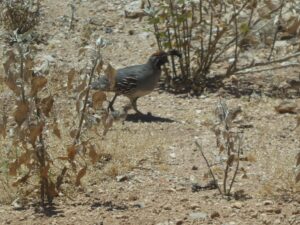
Mature Quickly
Each quail egg takes just 17 days to incubate. What’s also interesting is that some breeds of quail will start laying at just six weeks old. Compare that to the 24 weeks of a chicken or duck’s life that you need to wait before you get eggs.
That means when raising quail, the egg numbers will start to mount up fast while you’re waiting for the duck or chicken to lay eggs. Therefore, you can expect a high production of small eggs in a short time period.
Additionally, quails can be mated at around three weeks, and quail chicks will usually fetch a higher price than chickens.
Other Attributes
They are easy to raise and hardy to various climates with proper shelter. Also, unlike chicken roosters, male quail are quieter. Their crows don’t travel and shouldn’t disturb neighbors.
What Do Quail Look Like
Quail are smaller than chickens, typically with rounded bodies and smooth, decorative feathers. When it comes to appearance, most boast different shades of brown, grey, black, and white, while certain breeds have even more vibrant underbellies.
Some breeds have small plumes atop their heads designed to attract a mate.
Baby quail are also smaller than their chick counterparts. They’re covered in soft, light fuzz with distinctive markings along the face and down the back.
Over time, juvenile quail will lose their fluff and replace it with adult feathers—and, just like humans, they can look somewhat awkward in the interim.
Weight
Quail reach their adult size at around a month old, though they may not be sexually mature yet. Unlike chickens, females tend to be slightly larger than males. The weight for hens usually ranges between 4 and 5.5 ounces. The weight for a roo or cock tends to sit closer to 3.5 to 5 ounces.
Quail Traits & Temperament
Domesticated quail breeds tend to have a friendly disposition that makes them great as both farmyard birds and as pets.
Most quail owners find that their birds become adjusted to their presence over time. Some will even come when called, though most prefer not to be handled. Keep this in mind if you are someone who enjoys lap chickens. Quails aren’t as social.
Quail are popular as backyard birds in cities and suburbs in part because they’re quieter than chickens, roosters, or ducks. They mostly stick to low cooing and trilling as opposed to loud clucks.
While roos and cocks are able to crow, they don’t do it nearly as often nor as loudly as roosters.
Though quail are birds, they prefer to dwell on the ground. In the wild, they typically make their nests in low, brushy areas.
In captivity, quail also like to have a safe, quiet, enclosed space to nest. They like to roam during the day, foraging for anything that looks tasty.
While quail aren’t known to be avid flyers, they can lift off when frightened or alarmed. They have little control over their flight pattern, often opting to shoot up into the safety of nearby trees.
The average quail can fly higher than a chicken, meaning that it can clear walls several feet tall. It’s best to keep quail in a coop or run with an enclosed roof to prevent accidental escapes.
Quail hens do not go broody so if you want to hatch fertile eggs, you’ll have to incubate them yourself.

Hardiness
Quails are typically healthy birds. They are very easy to keep. As long as you keep everything clean, you shouldn’t run into any problems raising quails. Make sure you clean out the coop, food containers, and water supply every week to avoid issues. You’ll also need to protect them from the elements when the weather becomes more extreme.
Remember predators will be attracted to the quail and some to the quail eggs as well.
They are cold hardy game birds; however, when raising them you’ll need to ensure they have a draft-free shelter. It’s important they stay dry in cold months. Be sure their space is ventilated. Do not use a heat lamp in cold months. They are heat tolerant as well.
Whatever the climate, be sure they have shelter and protection from rain, snow, cold, shade for hot days, and protection from predators.
Apart from that, quails are pretty low maintenance and hardy.
How to Raise Quails
So, if you decided you’d like to add quail to your homestead flock to add variety to your egg production, here is how you can do it. While raising quail is fairly easy, it’s important that you prepare a proper living space. You should know how to keep your flock happy, healthy, and stress-free.
Living Space
Flocks of quail prefer living in close quarters, making them perfect for small coop spaces. Unlike chickens, they like to sit low to the ground, so it’s best to avoid anything with stilts or a ramp.
They also don’t typically need as much access to perch space, as most breeds prefer to roost on the floor.
If you have space, it’s always a good idea to include a run for your coop. This is an enclosed space where your quail can explore, stretch their legs, and find tasty treats such as insects, fresh grass, and more. If you can’t include a run, make sure that their coop has space for them to move around during their active period.
When raising quail, make sure that they always have access to plenty of feed and a clean water supply. You may even want to get hanging feeders to prevent any dirt, debris, or waste from getting kicked up into your flock’s food and water. Pick up quail droppings regularly.
Coop
You can build the quail’s coop so they can scratch around in the dirt. Another option is to build it slightly above ground to better protect them from predators. They prefer to be on the ground.
If you have an area for them to forage and exercise, be sure to secure it. In addition, protect animals from coming in with hardware cloth buried under the ground.
You should also give them at least one square foot of space per bird.
They don’t need a roosting perch as quails prefer to sleep on the ground, so keeping their coop clean is particularly important.
They also do not need nesting boxes, preferring to lay their eggs wherever they like, so sometimes you’ll have to hunt them down. Quails prefer an area to feel safe and secure so be sure to proper shelter.
Some quails may have favorite laying spots, while others will make it a little more difficult and just lay wherever they happen to be.
If you’re keeping your quails in cages, make sure you provide some stimulation for them. They’ll appreciate a dust bath or a sand tray, as well as some branches to make the environment more natural for them.
They’re sociable birds, so they may also prefer being in a cage altogether instead of being kept isolated in single cages.
Feeding Quail
You will need to refill your quail’s feeders and waterers daily. They need fresh water. Quails’ nutritional needs are different from chickens, although, like chickens, their diet will change depending on your reason for keeping them.
Like chickens and other poultry, quail are omnivores. When foraging, they will seek out insects and grubs.
Adult quail prefer a diet that’s primarily made up of grain. Fortunately for quail farmers, this makes feeding quail an easy task.
You can find special game bird feed in most farm supply stores, some home improvement stores, some pet stores, and online. There are different varieties depending on what stage your bird is at, from baby quail to mature adults.
Quail Chicks
Starter feed is ideal for growing chicks, as it usually contains around 30% protein.
Quail chicks can be fed game bird starter feed until around 6 – 8 weeks old. Once chicks are old enough, you can switch them to either grower or layer feed depending on why you are raising them.
- Switch meat producers onto a finisher feed
- Change egg layers and breeders onto a developer feed
Grower feed, also known as finisher feed, has a high protein content to help birds bulk up fast. It’s best fed to meat quail.
Layer feed, on the other hand, is designed to support egg-laying quail. It typically boasts a lower protein content than grower feed but has a higher calcium content to produce strong eggshells.
Feed mature layers layer feed. Otherwise, the eggshells may start to weaken. The production of eggs will also slow down.
How Much Do Quails Eat?
As an example, mature Japanese quail needs around 14g to 18g of feed per day, but needs can change depending on breed, maturity, and purpose.
Free-range quails with better access to their natural diet will produce richer eggs due to additional proteins from insects and grubs.
It may also be beneficial to supplement your quail’s diet with a 4% to 6% herbal feed supplement called Phyllanthus buxifolius.
It has been proven to increase quail immunity, thereby reducing mortality by protecting them from viral infection.
Light
Your quail flock will need access to plenty of light to maintain healthy fertility and egg production. Japanese quail need at least 14 to 18 hours of light per day, so you should consider supplementing their light source in winter months.
If you’re raising quail for meat, they won’t need as much light. Around 8 hours per day is sufficient.
How Many Quail to Raise
Quail are social birds, and owners need to have at least 2 in a flock or a covey to keep them happy. Advisably, you should have more in case of an accidental loss.
You can keep around 5 quails in the same space it takes to raise a single chicken, so it makes sense to have a larger flock.
No matter how large your flock might be, you need to pay attention to your rooster-to-hen ratio. With too many males, you may start seeing conflict within your coop. Male quail can get competitive in small spaces, or they can injure females through overbreeding.
It’s best to keep at least 3 – 4 females for every male quail that lives in your coop. If anything, err on the side of more hens. Just keep in mind that if you plan to breed your quail, you’ll produce fewer viable eggs.
Also consider quail lifespan. In captivity, they live to be 2 – 3 years old. With quail chicks and mature hens, you’ll have a reliable source of eggs.
You may decide to hatch chicks as well. You’ll need an chicken egg incubator as quail don’t go broody.
Predators
When raising livestock, you’ll always need to be aware of predators. As a small, delicate bird, quail need protection from plenty of different predators. Keeping quail chicks and mature birds them in a sealed coop or covered run is one of the best ways to keep your flock safe from neighborhood predators.
One of the most dangerous threats to backyard quail is aerial predators. Owls or hawks can easily snatch an unsuspecting quail wandering out in the open. Try to keep coops and runs both obscured and covered from above.
Large and small rodents can also be a threat to your quail. Even rodents too small to harm your birds, such as mice, can still destroy eggs and injure hatchlings. It’s important that you make sure that your quail’s living quarters are well sealed and that food and water are both contained.
In other areas, foxes, raccoons, opossums, bobcats, coyotes, and mountain lions will be attracted to quail.
If you live in the city or the suburbs, you’ll have to watch out for the local pet population. Both cats and dogs, especially prey-driven breeds, are attracted to quail.
Take steps to deter wandering pets from entering your yard by putting up a fence, removing other attractions, or simply talking to your neighbors.
Diseases
When you bring new quails into your coop, especially mature adults, you need to be careful about introducing disease into your flock. It’s always a good idea to quarantine new birds until you’re sure they aren’t displaying any symptoms. Commons concerns are:
- Ulcerative Enteritis
- Mites, Lice
- Internal Parasites
When raising quail, the most common illness to look out for in quails is Ulcerative Enteritis, also known as quail disease.
It spreads through droppings and can be fatal if left untreated. The most common signs include lethargy, watery droppings, and drooping wings. Fortunately, if caught early, a round of antibiotics should clear up any issues.
You should also be on the lookout for signs of mites and lice in your flock. Though not as deadly as quail disease, an infestation can lead to discomfort, plumage loss, and skin infection.
If you notice your flock itching or scratching, you may want to scrub down their living quarters to get rid of mites and their eggs.
Internal parasites are a less common issue in backyard quail flocks, but cases of roundworms or tapeworms aren’t unheard of amongst poultry owners.
If you notice changes in digestion or egg production, you may want to have a vet test for parasites.
Quail Breeds
Some quail breeds are more popular with breeders than others, depending on what you’re raising them for.
- Button quail
- Japanese quail also called Coturnix quail
- Regular
- Jumbo Coturnix
- Mountain quail
- Gambel’s
- King
Button quails are particularly small and produce tiny eggs, so while they make a good pet, they’re not good laying birds.
The Japanese quail is a fantastic layer, producing around 300 eggs per year, from as early as six weeks. Also known as Coturnix quail, they are one of the most highly recommended quail breeds for meat production. That is because they grow quickly and have more meat on its bones than other breeds.
To avoid any aggression between the birds, you should aim to limit the number of male quails in your flock to just one male for every four females.
If you’re only raising males, then you should cage them in pairs.
Buying Quail
If you want to raise quail, you can sometimes find young hatchlings and chicks in the spring at garden center, local hardware stores, and agricultural retailers. There may also be a specialized breeder in your area. Some breeders ship quail eggs as well.
If you have trouble finding chicks locally, you can always go online and order from small-scale or large-scale hatcheries.
FAQs
What are Quails?
Though quail are often compared to chickens, they’re part of the same family as pheasants and partridges. There are more than a hundred different species of quail from across the globe.
Historically, quail have been thought of as game birds in most parts of the world. It’s only relatively recently that quail have been transitioning to a farmyard bird. Most common quail breeds are still fairly wild and may not take to a coop as well as others.
Most modern domesticated flocks descend from the Japanese quail, Coturnix japonica. Japan was one of the few countries to embrace the quail as a domestic bird as early as the 11th century AD.
Though they were originally kept as ornamental songbirds, it wasn’t long before farmers began to breed quail for meat and eggs.
What is the Lifespan of a Quail?
Healthy, well-cared for quail living in captivity will live 2 – 3 years.
What are the Problems You May Encounter When Raising Quails?
Although there are many good reasons for raising quails, you should also factor in any negatives before raising them. The main disadvantage are their shorter lifespan, the high cholesterol content of their eggs, and the sheer amount of natural predators.
1. Shorter Lifespan
As we mentioned previously, quails can start laying in just 6 weeks, but they only live around 2 years.
That said, with a great number of eggs produced and short incubation time, you’ll have quails to replace the old or dying ones in no time.
2. More Natural Predators
Quails are also pretty low on the food chain. With their smaller size compared to chickens or ducks, they’re easier targets for most predators.
So, if you’re thinking of raising quails, you need to protect them from predators such as bobcats, foxes, coyotes, raccoons, opossums, snakes, owls, and hawks.
Many people choose to build quail coops raised off the ground to protect them from burrowing predators.
Raising Quail for Meat, Eggs, and More
Quail are attractive, low-maintenance birds that make just as good pets as they do farmyard poultry. You can use them for a sustainable source of meat and eggs. When raised correctly, they are fairly economical and easy to raise.
Whether you live in the country or the city, follow these tips for raising quail.

